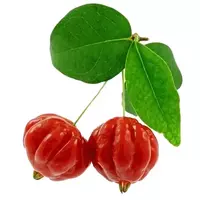Suriname pitanga cherry

The Surinamese pitanga cherry or one-flowered Eugene is a tree classified scientifically as the Myrtovs family. The Surinamese pitanga cherry plant itself or Eugenia uniflora differs in its rather modest size and does not exceed, as a rule,
7. 5 meters in height. The leaves of Suriname cherries have an oval and pronounced lanceolate pointed shape.
Surinasma pitanga cherry stands out against the background of other plants similar in structure and properties to the extraordinary ribbed form of its fruits. Notably, as the fruits of the Suriname pitanga cherry mature, they change their original color. Green fruits of surinasma cherry gradually acquire a bright red or maroon color.
The researchers note that pitanga resembles the fruits of ordinary cherries to its taste. However, Surinamese pitanga cherry is distinguished by the presence of mustard in taste. Suriname cherry grows both wild and cultivated in the territory of French Guinea, Paraguay, Colombia, Guyana, as well as in India, Venezuela, as well as in the Philippines and Antilles.
Pitanga fruits are enriched with vitamin C. Suriname cherries are eaten fresh or processed. On the basis of the fruits of Suriname cherries, islanders and residents of the territories of distribution of the plant have long made healing infusions and decoctions. Based on the decoction obtained from pitanga berries rich in vitamin C, a first-class vitamin-mineral drink is obtained, which helps to support the performance of the immune system of the human body.
The chemical composition of Suriname cherries is enriched with vitamins of groups A, B and C. In addition, the fruit of the plant contains such naturally beneficial natural compounds as magnesium, phosphorus, potassium, iron, sodium and calcium. In cooking, pitanga fruits are used in the same way as other varieties of cherries. Suriname cherries make delicious jams, jam, compotes, as well as filling for homemade baking.
Based on pitanga fruits, homemade wine is made, as well as vinegar. However, it is worth remembering that Suriname cherry has a specific taste, which is distinguished by a natural hill. In order to get rid of excessive bitterness, the fruits of Suriname cherries are covered with sugar and placed in the refrigerator for several hours and only then begin to prepare confectionery.
It is noteworthy that people use not only the taste and benefits of pitanga, but also the unusual appearance of Surinamese cherries, which are often grown as an ornamental plant. The largest number of varieties of Suriname cherry grows in Thailand, where the fruits of the plant are actively used, both in culinary and folk medicine. It is worth noting that each variety of Surinamese pitanga cherry differs in its individual and distinctive taste.
Surinamese pitanga cherry 33 kKal
Energy value of Suriname pitang cherry (Ratio of proteins, fats, carbohydrates - ju):
Proteins: 0.8 g (~ 3 kCal)
Fats: 0.4 g (~ 4 kCal)
Carbohydrates: 7.49g (~ 30kCal)
Energy ratio (bj | y): 10% | 11% | 91%
 Español
Español Français
Français Português
Português Русский
Русский 简体中文
简体中文 繁體中文
繁體中文 日本語
日本語 한국어
한국어 العربية
العربية Türkçe
Türkçe Қазақ
Қазақ Deutsch
Deutsch Italiano
Italiano Українська
Українська
